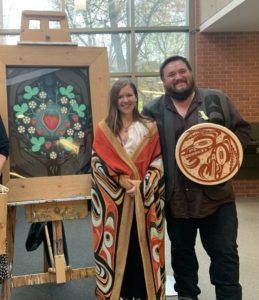The Lansdowne campus library has received a gift from a Camosun College student as the culmination of her Indigenous Education program. Alisha Parks is just finishing her second year of the program, and she says that her experience of being an Indigenous student with disabilities really shaped her inspiration for Gifts of the Heartberry, an acrylic painting on wood set in a cedar frame.
“We were encouraged to engage with community, and to do so under the guiding principles of respect, relevancy, relationship, and reciprocity,” she says. “We were encouraged to really find a project in a community that we feel like we can make a difference. For me, this really came out of my own lived experience of being an Indigenous student with disabilities and trying to navigate my educational journey at Camosun.”
Parks says that she wants to communicate the significance of her personal experiences to viewers using the language of artistic expression.

“I was thinking about this, very deeply, about the experience that we face as Indigenous people with disability,” she says. “As a person who has dealt with a lot of oppression, it was very important for me to try and bring this to people because of the impact it had on me, so I also felt that I wanted to try and do this project in a way that spoke in the language that I’m most fluent in, which has always been art.”
The heartberry is representative of gifts from nature, says Parks, and is a key component of how her people came to be.
“In my own culture, which is Kanienʼkehá꞉ka, or Mohawk, we have a lot of understanding around the medicine of the heartberry, or the strawberry,” she says. “It is believed that we began from Skywoman, and the heartberry came from Skywoman’s heart. This berry really represents gifts from creation, and so I wanted to bring that concept of gifts and gifting to this project. I wanted to gift this artwork, and I wanted to gift this way of seeing disability differently.”
The realization that many Indigenous languages do not have a word for disability had a profound impact on how Parks views the concept, she says, and she believes that by changing our perception of disability, we can functionally eradicate it.
“Many Indigenous languages across Turtle Island don’t have a word for disability, and that is because disability is really a social construct,” Parks says. “So this really shifted my understanding and thinking around what is possible, and how we can support people. It changes your perspective. Instead of seeing disability as a deficiency within the individual, it shifts it to saying, actually, it’s the way in which we structure our social networks, and how we structure the systems that we utilize that create that, and it doesn’t need to. We can do that differently.”
Parks says there is a key difference between disability and impairment, and even those who are significantly impaired need not be considered disabled if they have the support of those around them.
“Certainly, it’s not to say that we don’t suffer from having disabilities or differences. Sometimes it’s painful, but often times, it’s the social implications that cause us much more suffering than the impairments which we face,” says Parks. “We kind of have this myth of independence in Eurocentric ways of being, and I think that’s the gift that my disability has given me, is understanding deeply that we don’t do anything alone. We are always interdependent, we are always interrelated. So long as we’re supported in a community, there is no deficiency.”
